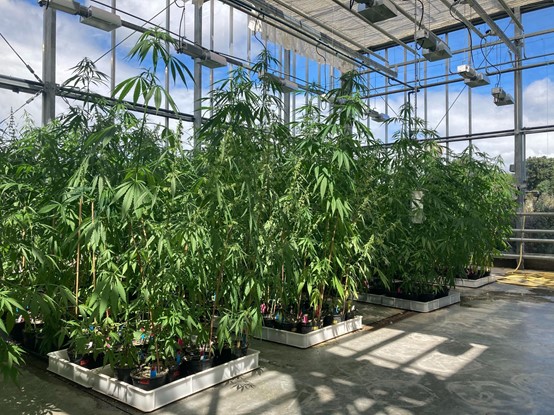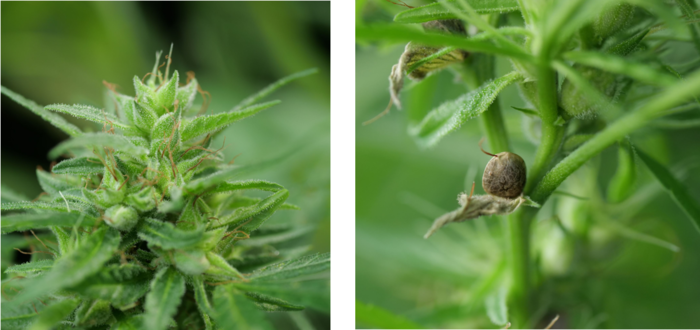Caroline Dowling from the UCD School Biology and Environmental Science tells us why Cannabis is a most versatile yet misunderstood crop, with uses in medicine, energy, construction and more.
Cannabis is a famous yet very misunderstood species. Some Cannabis plants produce tetrahydrocannabinol (THC), an intoxicating compound that can be used recreationally. As a result, most people think Cannabis is only a drug. But Cannabis is legally split into two groups based on THC content: hemp (fibre-type, below 0.3% THC) or marijuana (drug-type, above 0.3% THC).

Hemp plants analysed for flowering time in the greenhouse. Photo credit: Jiaqi Shi
Hemp is a versatile crop and is used to produce biofuel, textiles, paper and even building materials such as hempcrete. Cannabidiol (CBD) is a non-intoxicating compound produced in hemp flowers and can be used to treat conditions such as epilepsy and multiple sclerosis. Furthermore, hemp is an effective break crop and an efficient bioenergy crop as it grows very fast, sequestering large amounts of carbon. For these reasons, hemp farming is becoming increasingly popular globally, including in Ireland. However, due to the illicit connotations of marijuana, Cannabis (including hemp) was banned for most of the 20th century. As a result, a knowledge gap exists for this species and the UCD Flower Power lab is addressing this gap.
Specifically, we research the genes that control different traits in Cannabis, including flowering time. The timing of flowering is a tightly controlled process affected by both external and internal signals. It is in an intricate network of genetics, plant hormones, temperature and light sensing that produces the eventual signal for the plant to transition from vegetative growth to producing flowers. Cannabis is a short-day species, meaning the plant requires days with long periods of darkness to flower. Therefore, to grow Cannabis at northern latitudes (summer days can have over 17 h of daylight in northern Europe), plants that flower earlier would be favourable to ensure sufficient flower and seed production. On the other hand, if the intended harvest is for biomass or fibre production, plants that flower later would be beneficial. Therefore, to integrate Cannabis into modern agriculture and support the production of sustainable, hemp-based resources, a thorough understanding of the genetic control of flowering time is required.

(Left) Plant hairs on female Cannabis flowers produce cannabinoids that have various medical applications. (Right) Cannabis seeds are edible, and the oil can be consumed by humans or refined for biofuel. Photo credit: Jiaqi Shi
To do this, we use a technique called trait mapping, whereby we cross two individuals with very different flowering times. This cross’s grandchildren (also called an F2 population) display a spectrum of flowering times. By analysing the genetic makeup of these individuals, we can identify what genes are controlling flowering time in Cannabis. This information is invaluable for breeders, providing them with the power to fine-tune the flowering time of new Cannabis cultivars to the local climatic conditions.
Essay first published 9 June 2021
About the author
Caroline Dowling is a PhD candidate in the School of Biology and Environmental Science and is funded by the Irish Research Council and the Environmental Protection Agency. Her research investigates the genetic control of complex traits, such as flowering time, in Cannabis sativa. Caroline represents the Plants for the Future theme on the Earth Institute associate member committee. She is also a member of HempHub, a knowledge hub focused on hemp research and a strategic priority of the UCD Earth Institute. Twitter: @CarolineD0wling
About the series
The A-Z of Environmental, Climate and Sustainability Research is a new series of short essays by UCD postdoctoral and postgraduate researchers, technical and research support staff, about their work. The series is developed and curated by the Earth Institute Associate Member Committee led by Hannah Gould, a PhD student at BiOrbic and the UCD School of Architecture, Planning and Environmental Policy, and Earth Institute Communications and Engagement Officer Liz Bruton. If you'd like to submit a piece for the series do get in touch!
Find out more about the Anthropocene with Nick Scroxton, Bees with Katherine Burns, Cannabis with Caroline Dowling, Degrowth with Ciarán O'Brien, Education with Georgina Fagan, Finance with Shane McGuinness, Gaia with Federico Cerrone, Hydrometry with Kate de Smeth, Innovation with Hannah Gould, Justice with Lauren Minion, Kelp with Priya Pollard, Landscape part 1 with Tomas Buitendijk, Landscape part 2 with Amy Strecker and Amanda Byer, Reusing microbial ‘bathwater’ for sustainable drug production with Laura Murphy, and Mammals with Virginia Morera-Pujol in our latest essays.
Further reading
To read more about Caroline’s research check out this article in the US magazine Hemp Grower
Kwai, I. (2020). U.N. reclassifies Cannabis as a less dangerous drug. The New York Times, 2 December
Salentijn, E. M. J., Petit, J. and Trindade, L. M. (2019). The complex interactions between flowering behavior and fiber quality in hemp. Front. Plant Sci. 10, 614
Schilling, S., Dowling, C. A., Shi, J. et al. (2020). The Cream of the Crop: Biology, Breeding and Applications of Cannabis sativa. Authorea Preprints.


